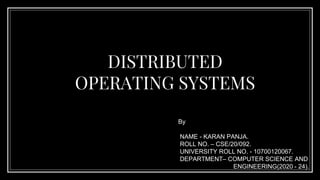
OS .pptx
- 1. DISTRIBUTED OPERATING SYSTEMS By NAME - KARAN PANJA. ROLL NO. – CSE/20/092. UNIVERSITY ROLL NO. - 10700120067. DEPARTMENT– COMPUTER SCIENCE AND ENGINEERING(2020 - 24).
- 2. Introduction Distributed Operating System is a model where distributed applications are on running on multiple computers linked by communications. A distributed operating system is an extension of the network operating system that supports higher levels of co mmunication and integration of the machines on the network.This system looks to its users li ke an ordinary centralized operating system but runs on multiple, independent central processing units (CPUs). Distributed systems use multiple central processors to serve multiple real time applicati on and multiple users. Data processing jobs are distributed among the processors accord ingly to which one can perform each job most efficiently. These systems are referred as loosely coupled systems where each processor has its own local memory and processors communicate with one another through various communica tion lines, such as high speed buses or telephone lines. By loosely coupled systems, we mean that such computers possess no hardware connections at the CPU memory bus leve l, but are connected by external interfaces that run und-er the control of software. 2
- 3. Examples Of Distributed OS WWW (world wide web ) is the biggest example of Distributed OS. Others are:- ● The internet. ● Intranet which is the portion of the internet which is managed by an organization. 3
- 4. 4
- 5. Distributed Computing Models Three basic distributions : Organization : A centralized system has one level of structure, where all constituent elements directly depend upon a single control element. A decentralized system is hierarchical. The bottom level unites subsets of a system’s entities. These entity subsets in turn combine at higher levels, ultimately culminating at a central master element. A distributed system is a collection of autonomous elements with no concept of levels. Connection : Centralized systems connect constituents directly to a central master entity in a hub and spoke fashion. A decentralized system (aka network system) incorporates direct and indirect paths between constituent elements and the central entity. Typically this is configured as a hierarchy with only one shortest path between any two elements. Finally, the distributed operating system requires no pattern; direct and indirect connections are possible between any two elements. Control : Centralized and decentralized systems have directed flows of connection to and from the central entity, while distributed systems communicate along arbitrary paths. This is the pivotal notion of the third consideration. Control involves allocating tasks and data to system elements balancing efficiency, responsiveness and complexity. 5
- 6. Design Considerations Transparency : Transparency or single-system image refers to the ability of an application to treat the system on which it operates without regard to whether it is distributed and without regard to hardware or other implementation details. Many areas of a system can benefit from transparency, including access, location, performance, naming, and migration. Inter-process communication : Inter-Process Communication (IPC) is the implementation of general communication, process interaction, and dataflow between threads and/or processes both within a node, and between nodes in a distributed OS. The intra-node and inter-node communication requirements drive low-level IPC design, which is the typical approach to implementing communication functions that support transparency. Reliability : Distributed OS can provide the necessary resources and services to achieve high levels of reliability, or the ability to prevent and/or recover from errors. Faults are physical or logical defects that can cause errors in the system. For a system to be reliable, it must somehow overcome the adverse effects of faults. 6
- 7. Design Considerations(Cont.) Performance : Many benchmark metrics quantify performance; throughput, response time, job completions per unit time, system utilization, etc.With respect to a distributed OS, performance most often distills to a balance between process parallelism and IPC. Managing the task granularity of parallelism in a sensible relation to the messages required for support is extremely effective .Also, identifying when it is more beneficial to migrate a process to its data, rather than copy the data, is effective as well. Flexibility : Flexibility in a distributed operating system is enhanced through the modular and characteristics of the distributed OS, and by providing a richer set of higher-level services. The completeness and quality of the kernel/microkernel simplifies implementation of such services, and potentially enables service providers greater choice of providers for such services. 7
- 8. Give more performance than single system If one pc in distributed system malfunction or corrupts then other node or pc will take care of More resources can be added easily Resources like printers can be shared on multiple pc’s Advantages 8
- 9. Security problem due to sharing Some messages can be lost in the network system Bandwidth is another problem if there is large data then all network wires to be replaced which tends to become expensive Overloading is another problem in distributed operating systems The databases in network operating is difficult to administrate then single user system Disadvantages 9
- 10. Thank You! 10